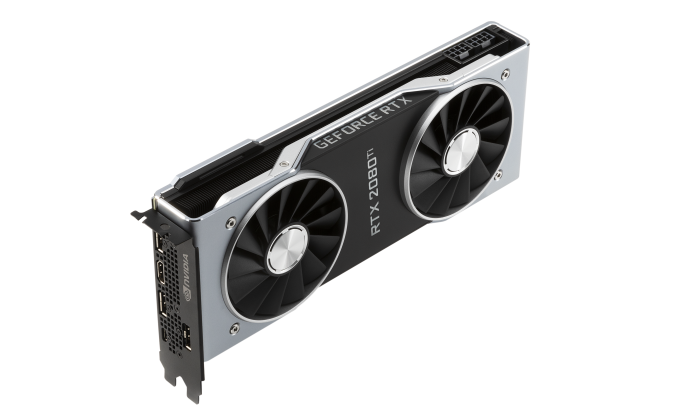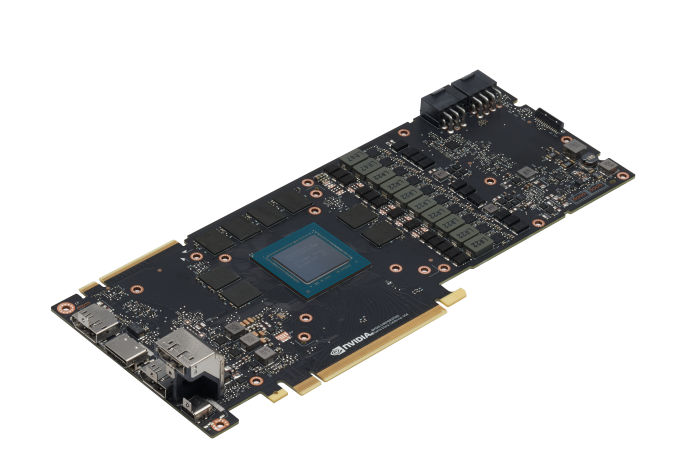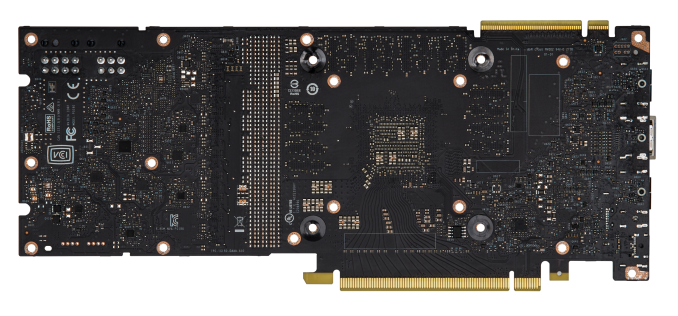The NVIDIA GeForce RTX 2080 Ti & RTX 2080 Founders Edition Review: Foundations For A Ray Traced Future
by Nate Oh on September 19, 2018 5:15 PM EST- Posted in
- GPUs
- Raytrace
- GeForce
- NVIDIA
- DirectX Raytracing
- Turing
- GeForce RTX
Meet The GeForce RTX 2080 Ti & RTX 2080 Founders Editions Cards
Moving onto the design of the cards, we've already mentioned the biggest change: a new open air cooler design. Along with the Founders Edition specification changes, the cards might be considered 'reference' in that they remain a first-party video card sold direct by NVIDIA, but strictly-speaking they are not because they no longer carry reference specifications.
Otherwise, NVIDIA's industrial design language prevails, and the RTX cards bring a sleek flattened aesthetic over the polygonal shroud of the 10 series. The silver shroud now encapsulates an integrated backplate, and in keeping with the presentation, the NVLink SLI connectors have a removable cover.
Internally, the dual 13-blade fans accompany a full-length vapor chamber and component baseplate, connected to a dual-slot aluminum finstack. Looking at improving efficiency and granular power control, the 260W RTX 2080 Ti Founders Edition features a 13-phase iMON DrMOS power subsystem with a dedicated 3-phase system for the 14 Gbps GDDR6, while the 225W RTX 2080 Founders Edition weighing in with 8-phases main and 2-phases memory.
As is typical with higher quality designs, NVIDIA is pushing overclocking, and for one that means a dual 8-pin PCIe power configuration for the 2080 Ti; on paper, this puts the maximum draw at 375W, though specifications-wise the TDP of the 2080 Ti Founders Edition against the 1080 Ti Founders Edition is only 10W higher. The RTX 2080 Founders Edition has the more drastic jump, however, with 8+6 pins and a 45W increase over the 1080's lone 8 pin and 180W TDP. Ultimately, it's a steady increase from the power-sipping GTX 980's 165W.
One of the more understated changes comes with the display outputs, which thanks to Turing's new display controller now features DisplayPort 1.4 and DSC support, the latter of which is part of the DP1.4 spec. The eye-catching addition is the VR-centric USB-C VirtualLink port, which also carries an associated 30W not included in the overall TDP.
Something to note is that this change in reference design, combined with the seemingly inherent low-volume nature of the Turing GPUs, cuts into an often overlooked but highly important aspect of GPU sales: big OEMs in the desktop and mobile space. Boutique system integrators will happily incorporate the pricier higher-end parts but from the OEM’s perspective, the GeForce RTX cards are not just priced into a new range beyond existing ones but also bringing higher TDPs and no longer equipped with blower-style coolers in its ‘reference’ implementation.
Given that OEMs often rely on the video card being fully self-exhausting because of a blower, it would certainly preclude a lot of drop-in replacements or upgrades – at least not without further testing. It would be hard to slot into the standard OEM product cycle at the necessary prices, not to mention the added difficulty in marketing. In that respect, there is definitely more to the GeForce RTX 20 series story, and it’s somewhat hard to see OEMs offering GeForce RTX cards. Or even the RT Cores themselves existing below the RTX 2070, just on basis of the raw performance needed for real time ray tracing effects at reasonable resolutions and playable framerates. So it will be very interesting to see how the rest of NVIDIA’s product stack unfolds.
















337 Comments
View All Comments
Bp_968 - Sunday, December 2, 2018 - link
Even though the review is older and this comment is a few months old I just wanted to jump in and say "hah, look, eddman was right!" Now that the Titan RTX leaks are showing up. Lol. They didn't even wait for supply to stabilize on the 2080ti before dropping the titan.Plus, if the 2080 replaced the 1080ti then why is it more expensive and no faster? That would be a first even for Nvidia..
PeachNCream - Thursday, September 20, 2018 - link
The model numbers aren't that significant. NVIDIA could just have easily released a 2080, a 2070, and a 2060 by putting different labels on the boxes of the 2080 Ti, the 2080, and the 2070 for instance. The Ti, the Titan, all of those are long standing marketing identities that buyers now automatically associate with a certain relative scale of performance among other GPUs of the same generation. NVIDIA can play upon buyer expectations by releasing various products to fill those expectations in the way that best advances the company's interest. Any company with enough brand recognition can easily do the same. Consider Intel's long-running i-series CPU numbering. The fact that something labeled as a Ti came out at a certain time isn't an example of technological development, but a way of meeting customer expectations in reflection of the MSRP. We would have balked much more at $1200 for the exact same product if it was labeled as a plain vanilla 2080 and the current vanilla 2080 was branded as a 2070. Instead, we say, "Well, the 2080 Ti is really expensive, but at least its a Ti so that makes it a little bit more reasonable."eddman - Thursday, September 20, 2018 - link
Model numbers are significant in the way that they point out the models in the same successive line up. That's the entire point of them.I and a lot of people are not in this "we" you talk about. Again, nvidia themselves compare it to 1080 Ti every chance they get, so I do not see why I should in any way think its price is "reasonable".
That's not how past generational leaps worked, even for 8800 GTX. We got massive performance gains AND usually new rendering features at similar MSRPs or maybe a bit higher. The difference this time is that AMD has left the building, for now.
PeachNCream - Thursday, September 20, 2018 - link
Don't misunderstand me. I'm not implying that the price is okay or that anyone should find it reasonable to stomach a $1200 MSRP for a mere graphics card. I also agree that part of the pricing problem is due to an absence of credible competition from AMD. I'm just arguing that the people in the NVIDIA marketing department may justify the price in part by slapping a Ti label on the box so consumers are less likely to balk during checkout. The reality is that we're getting a step sideways in performance for a noteworthy increase in TDP due to the addition of capabilities that may or may not actually add much value because said features are too demanding to play nicely at high resolutions and because there are not indications that the software side will move to take advantage of said features. At best, the addition of the hardware won't be very compelling until the next generation of GPUs after Turing when its likely that performance will pick up a bit.Then again, who am I to talk? I play PC games on a laptop with an HD 4000 infrequently and end up mostly gaming on my ancient dual core Kitkat era phone that I've been keeping as a cheap wireless mini tablet. To me, PC gaming became an overly pricey sink of my limited, single parent free time. I'd rather bank my spare money in something that yields interest over time than throw it into gaming hardware that's obsolete in a matter of a few years. That and my kids me to be both of their parents these days since that worthless ex of mine schlepped off to marry some woman in Canada. *grumble*
tamalero - Thursday, September 20, 2018 - link
More like that they are pricing their high end cards like they are flagship cards.The 2080 Founders seems identical in price to a 1080TI. That is unacceptable. Specially when they are almost identical in performance (going slower in most games by a few small points).
They(Nvidia) just want to clear the huge build up of PASCAL cards.. by charging insanity for those who are willing to claim to be "gamers" with money. period.
tamalero - Thursday, September 20, 2018 - link
"You, like so many others don't get it. nVidia has re-worked their product lines. Didn't you notice how the Ti came out at the same time as the 2080?"What the hell does this has to do? Nothing for the consumer again.
tamalero - Thursday, September 20, 2018 - link
"Die size is not irrelevant to consumers because increased die size means increased cost to manufacture. Increased cost to manufacture means a pressure for higher prices. The question is what you get in return for those higher prices."
You're repeating the same.
Die size means NOTHING to a consumer. It means something for the manufacturer because it costs THEM.
If the die doesnt benefit anything at all (Fermi) compared to smaller dies that offer almost the same performance (Pascal). Why would the consumer have to pay MORE for LESS?
New tech is nothing if there is nothing to show. And there is NOTHING to show right now.
by the time raytracing becomes really viable, the new generation of cards will be out.
Spunjji - Friday, September 21, 2018 - link
This x1000. These cards are a necessary step towards getting the technology out there, but I'm thoroughly unconvinced that it is a good idea for anyone to buy them. The sacrifice in die area was too great, for far too little benefit. Given the strong indications that 1080p ~45fps is where real-time raytracing will be at right now, I just don't care. They sold me on high-resolution and high-framerate because those actually affect how much enjoyment I get from my games. I'm not interested in that rug being pulled from under my feet *and* paying damn near double price for the privilege.Morawka - Wednesday, September 19, 2018 - link
Doesn't TSMC charge their customers by the wafer nowadays?PopinFRESH007 - Wednesday, September 19, 2018 - link
how does that matter? Are you suggesting that magically makes the die size irrelevant? If you have a 300mm wafer and you double the die size, you also halve the number of die per wafer. This would also ignore yield. A larger die is more costly to produce because you get fewer die per wafer and increase the probability of having a defect within a die.